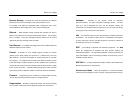
Wireless PCI Adapter
53
DHCP (Dynamic Host Configuration Protocol) – A protocol that lets
network administrators centrally manage and automate the assignment of
Internet Protocol (IP) addresses in an organization’s network. Using the
Internet’s set of protocol (TCP/IP), each machine that can connect to the
Internet needs a unique IP address. When an organization sets up its
computer users with a connection to the Internet, an IP address must be
assigned to each machine. Without DHCP, the IP address must be entered
manually at each computer and, if computers move to another location in
another part of the network, a new IP address must be entered. DHCP lets a
network administrator supervise and distribute IP addresses from a central
point and automatically sends a new IP address when a computer is plugged
into a different place in the network.
DHCP uses the concept of a “lease” or amount of time that a given IP address
will be valid for a computer. The lease time can vary depending on how long
a user is likely to require the Internet connection at a particular location.
It’s especially useful in education and other environments where users change
frequently. Using very short leases, DHCP can dynamically reconfigure
networks in which there are more computers than there are available
IP addresses.
DHCP supports static addresses for computers containing Web servers that
need a permanent IP address.
DNS – The Domain Name System (DNS) is the way that Internet domain
names are located and translated into an Internet Protocol (IP) address.
A domain name is a meaningful and easy-to-remember “handle” for an Internet
address.
Wireless PCI Adapter
54
Domain – A sub network comprised of a group of clients and servers under
the control of one security database. Dividing LANs into domains improves
performance and security.
Download – To receive a file transmitted over a network. In a
communications session, download means receive, and upload means
transmit.
Driver – A workstation or server software module that provides an interface
between a network interface card and the upper-layer protocol software
running in the computer; it is designed for a specific NIC, and is installed during
the initial installation of a network-compatible client or server operating system.
DSSS (Direct-Sequence Spread-Spectrum) – DSSS generates a
redundant bit pattern for each bit to be transmitted. This bit pattern is called a
chip (or chipping code). The longer the chip, the greater the probability that
the original data can be recovered. Even if one or more bits in the chip are
damaged during transmission, statistical techniques embedded in the radio can
recover the original data without the need for retransmission. To an
unintended receiver, DSSS appears as low power wideband noise and is
rejected (ignored) by most narrowband receivers.
Dynamic IP Address – An IP address that is automatically assigned to a
client station in a TCP/IP network, typically by a DHCP server. Network
devices that serve multiple users, such as servers and printers, are usually
assigned static IP addresses.


















